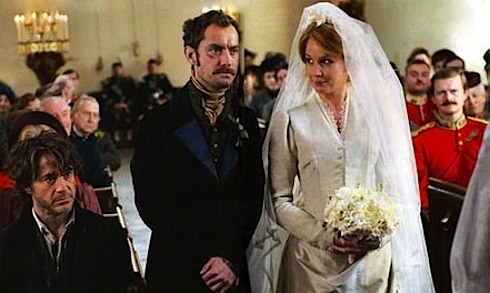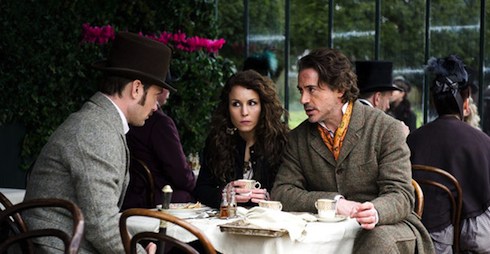I think I injured my fellow theater-goer with the amount of excited arm-punching I did during Sherlock Holmes: A Game of Shadows. With the popularity of BBC’s Sherlock, it seems that fans have grown a little combative about how they prefer their Holmes and Watsons’, but I think there’s a lot to enjoy across the board these days. Coming back after two years to watch Downey amp up his personal brand of sheer spastic madness was entirely welcome.
LOTS OF SPOILERS BELOW.
If you were concerned about villains, rest assured, Jared Harris turns in a genuinely frightening James Moriarty. There was something just unsettling enough about his delivery to make you shift in your seat whenever he spoke, an impressive feat all by itself, as subtlety has never been a hallmark of the character when portrayed on screen. Is his “I’m trying to start the first world war so I can make all the money” plot a bit awkward? Perhaps, but then, as the “Napoleon of Crime” I’m not quite sure what else he should be doing.
Confession time: I was sort of thrilled that Irene Adler was taken out of the picture so quickly. While I didn’t mind the position the character occupied in the narrative of the last movie, Rachel McAdams’ Adler never meshed well with this particular Holmes. The near-paternal tint in his affection for her was bothersome, and not missed this time around. Her absence opened the door to a more dynamic female character—Noomi Rapace’s Simza. It was encouraging to see a woman involved who didn’t have to be either man’s love interest, who could hold her own in a fight without toting a machine gun or breaking out tae kwon do, and wasn’t being flaunted on screen in an overtly sexual manner.

In fact, Ritchie’s Holmes universe continues to show a surprising amount of respect for its female characters; Adler is lovestruck, but she is still clever and dangerous, Simza can take a hit and throw a knife, Mary is never portrayed as some nasty ball-and-chain shrew who just “doesn’t get” her husband. It would be easy to vilify women or ignore them entirely when the primary focus of these stories is Holmes and Watson’s “relationship” (as Holmes likes to put it), but this retelling never stoops in that direction.
Speaking of Holmes and Watson, if the homo-socialism/eroticism of the last film made you uncomfortable, you might want to avoid this one. It seems as though audience bemusement (and the actors egging it on) led to even more glorious double-entendres, meaningful glances, and then dancing! Whether you prefer to view the duo as brothers in bond or something more, it’s intriguing (and appreciated by many) that one version of Holmes and Watson on film pushes the envelope a little further in that regard. Frankly, a large part of the last film’s success was down to the delightful chemistry between Law and Downey, so if that’s not something you enjoy, why would you be going to see the sequel in the first place?
The globe-trotting ala Bond did this movie a lot of favors, especially as outside a few stock shots of Paris, the audience is shown France, Germany and Switzerland in a fairly unstereotypical manner. And then, of course, our trio get to the peace conference, which is being held in beautiful fortress-type deal positioned over a waterfall uh oh.

Where the action is concerned, Guy Ritchie was clearly looking to top the sequences of the first film, and he succeeded in scale, at least. Holmes does do his pre-fight-walk-through the same as before and while the surprise factor has diminished, there is a fun in the expectation of it, of being in on the joke. The end reward of this continued manner of delivery—Moriarty’s table turning at the end, leading to a lovely Reichenbach homage—serves its chilling purpose. (They’re dueling in their heads! In their heads!)
On the other hand, the escape from the arms factory ended up dragging. It was an interesting idea in theory, but it went far too long. Are the advanced weapons we get from the factory sort of silly? Yes, they really are. Does it hurt the story too terribly? I don’t think so, as they aren’t dwelled on beyond that piece of the plot. If they had spent the rest of the movie taking out Moriarty’s men mafia style, that would have been an awful mistake. I feel I should point out that Sebastian Moran, one of the more formidable villains from the Holmes stories, is a particularly forgettable character here and really wasn’t needed in the film at all.
Oh, Mycroft. When it was announced that Stephen Fry would be playing Mycroft Holmes, I think I was expecting something close to book canon in the performance. Instead, we were treated to an elder Holmes who really did seem related to Downey’s: every bit as eccentric, albeit with different tastes and habits (that are equally alarming). I couldn’t have been more delighted with him and his rapport with Sherlock; it was readily discernible that these Holmes brothers had grown up together, were well aware of each other’s oddities and accustomed to handling them. And of course, it’s obvious who’s the older brother from that oxygen supply scene—”Can I have this weird thing because I like it?” “No, little one, put it back.”
This movie ran many dangers of just playing out its old pattern (this time with more gun fights!), but instead they ran a good balancing act. I recall wincing when I saw them rehashing the “get what’s in your hand out of my face” joke in the trailer, and funny enough, the joke was removed from the final cut. Clearly, the team behind this film still wants the material to feel fresh, and they’ve done a great job in upping the stakes; the first film now almost feels charmingly quaint by comparison, but that’s not a bad thing. If they make another follow up, I’ll happily hop back to my theater seat, nosh on stale popcorn and laugh the whole way through.
[Need more Holmes? Read how Tor.com will be obliging you starting this Thursday, the 22nd.]
Emmet Asher-Perrin was Jude Law Watson for Hallowe’en last year. Her cane was badass. You can bug her on Twitter and read more of her work here and elsewhere.










